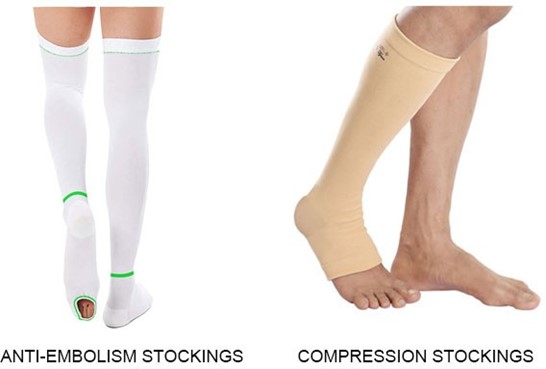A nurse is monitoring an assistive personnel (AP) who is applying elastic antiembolic stockings for a client who has phlebitis. Which of the following actions by the AP indicates that they are performing the skill correctly?
Rolls the extra stocking material down to the client's knee
Massages the legs before applying the stockings
Elevates the legs before applying the stockings
Positions the client in a chair before applying the stockings
The Correct Answer is C
Elevating the legs helps to reduce swelling and promotes venous return, which is beneficial for a client with phlebitis. This action improves circulation and aids in preventing the formation of blood clots.
Rolls the extra stocking material down to the client's knee: This action is incorrect because elastic antiembolic stockings should be applied evenly and smoothly without any excess material. Rolling down the extra material can create folds and wrinkles, which can compromise the effectiveness of the stockings and potentially cause discomfort or impaired circulation.
Massages the legs before applying the stockings: Massaging the legs before applying antiembolic stockings is not recommended. Massaging can stimulate blood flow and may dislodge any existing blood clots, posing a risk of embolism. It is important to handle the legs gently and avoid any aggressive or manipulative actions that can disturb the clots.
Positions the client in a chair before applying the stockings: Positioning the client in a chair before applying antiembolic stockings is not the correct action. It is preferable to have the client lie flat in a supine position, with the legs elevated, while applying the stockings. Lying flat helps improve venous return and ensures proper alignment and positioning of the stockings.

Nursing Test Bank
Naxlex Comprehensive Predictor Exams
Related Questions
Correct Answer is B
Explanation
The nurse should include maintaining elbow restraints on the infant in the plan of care following cleft palate repair. This helps to prevent the infant from touching their surgical site and disrupting the healing process.
a) Allowing the infant to have soft foods may be appropriate, but it is not the highest priority. The infant's diet should be determined by the provider and based on the infant's individual needs.
c) Instructing the parents to feed the infant with a spoon may be appropriate, but it is not the highest priority. The infant's feeding method should be determined by the provider and based on the infant's individual needs.
d) Telling the parents to avoid brushing the infant's teeth for two weeks may be appropriate, but it is not the highest priority. The infant's oral care should be determined by the provider and based on the infant's individual needs.
Correct Answer is ["A","B","E"]
Explanation
Compartment syndrome is a condition characterized by increased pressure within a closed anatomical space, such as a compartment in the leg. This increased pressure can compromise blood flow and nerve function. When assessing a client with a long-leg cast who reports severe pain, the nurse should be vigilant for signs and symptoms of compartment syndrome.
Option a is a correct answer because pallor (paleness) in the exposed portion of the left foot may indicate compromised blood flow due to increased pressure within the compartment.
Option b is a correct answer because the inability to move the left foot suggests impaired nerve function,
which can be a sign of compartment syndrome.
Option c is not a correct answer. Increased warmth is not typically associated with compartment syndrome; instead, it may suggest inflammation or infection.
Option d is not a correct answer. Ecchymosis (bruising) is not typically associated with compartment syndrome, as it is more commonly observed in cases of injury or trauma.
Option e is a correct answer because paresthesia (abnormal sensations like tingling or numbness) in the left foot can indicate nerve compression and is a potential symptom of compartment syndrome.
By identifying the presence of pallor, inability to move the foot, and paresthesia, the nurse can recognize indications of compartment syndrome and take appropriate actions to address the condition promptly.
Whether you are a student looking to ace your exams or a practicing nurse seeking to enhance your expertise , our nursing education contents will empower you with the confidence and competence to make a difference in the lives of patients and become a respected leader in the healthcare field.
Visit Naxlex, invest in your future and unlock endless possibilities with our unparalleled nursing education contents today
Report Wrong Answer on the Current Question
Do you disagree with the answer? If yes, what is your expected answer? Explain.
Kindly be descriptive with the issue you are facing.
